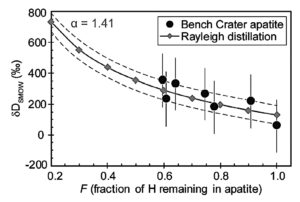Piralla, M. ; Tartèse, R. ; Marrocchi, Y. ; Joy, K.H. (2021) Meteoritics & Planetary Science, 56, 4, 809-828
Voir en ligne : https://doi.org/doi:10.1111/maps.13639

Abstract :
Apatite has been widely used for assessing the volatile inventory and hydrothermal fluid compositions of asteroidal and planetary bodies. We report the OH, F, and Cl abundances, as well as the hydrogen isotope composition, of apatite in the CM1-2 chondrite Boriskino and in the C1-ungrouped Bench Crater meteorite. Apatite in both meteorites is halogen-poor, close to the hydroxylapatite endmember composition, and characterized by average δDSMOW values of −226 +-59% and 233 +-92%, respectively. Compared to apatite, the matrix in Bench Crater is depleted in D with a δDSMOW value of −16 +-119‰. Comparing apatite and water H isotope compositions yields similar apatite-water D/H fractionation ΔDApatite-Water of approximately 120–150‰ for both chondrites, suggesting that apatite formed at similar temperatures. Combining a lattice strain partitioning model with apatite F and Cl abundances in Boriskino and Bench Crater yields low F and Cl abundances <300 μg g−1 in apatite-forming fluids, and fluid F/Cl ratios that are roughly consistent with the bulk F/Cl ratios of other CI and CM chondrites. This suggests that hydrothermal alteration on these meteorite parent bodies took place under closed-system conditions. Based on the OH abundance estimates for the apatite-forming fluids, we estimated the pH values of alteration fluids to be of approximately 10–13. Such alkaline fluid compositions are consistent with previous modeling and suggest that apatite formed late, toward the end of completion of hydrothermal alteration processes on the Boriskino and Bench Crater parent bodies.



